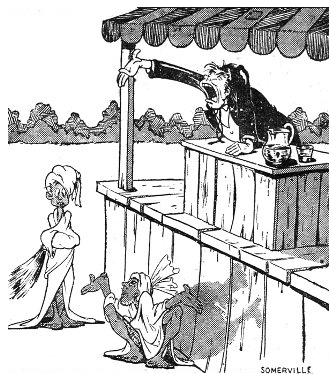|
|
|

VOL. III NO. 17 REG NO. L5015 DELHI, THURSDAY JANUARY 4, 1945
|
WASHINGTON - (UP) - Washington military experts believe the Jap Fleet may be forced out from hiding again, this time to deal with the mounting threat caused by Saipan-based B-29's on Hirohito's war industries.
The Japs have made ineffective attempts to knock out the Saipan bases using long-range bombers.
|
The experts see three possible counter-moves for the enemy: Firstly, to neutralize Saipan by carrier aircraft attacks; secondly, to bombard the bases from surface warships; thirdly, to attempt a landing to retake Saipan. Any of these moves would be hazardous, but the situation, it is believed, is growing so desperate the Japs may take the gamble.
Best available estimates on Japan's carrier strength give them seven first-line carriers as compared to 25 for the U.S., plus over 60 escort carriers.
In the meantime, Under-Secretary of War Robert P. Patterson, just returned from a tour of the Pacific, warned the nation that Japan is still a "formidable" war machine. He said he found nothing to support the notion that we can dispose of Japan in short order once Germany is beaten.
Secretary of the Navy James E. Forrestal took the opportunity to report that the U.S. Fleet has entered its fourth year of war with 1,185 fighting ships and 37,000 planes, but warned that operational plans for 1945 are threatened by lagging production.
He said that the total of combatant ships now available are more than three times the number at the beginning of the war, and that they are backed by 59,878 landing craft and auxiliary vessels.

|
Wedemeyer Says China
Co-operating With U.S.
CHUNGKING - (ANS) - China must fight her own war, with the U.S. giving all possible help, declared Maj. Gen. A. C. Wedemeyer, Commander of American Forces in the China Theater.
Wedemeyer said he did not know just how much China could contribute to the war but added that the Chinese were co-operating with the Americans in splendid fashion. He added that Japanese forces between Changsha and Indo-China presented strong offensive possibilities. He declared the Japs had not strengthened their forces in South China recently.
Just returned from a tour of the Yunnan border region, Wedemeyer said the land route to China was almost clear now. He said he saw American Engineers "working their heads off" in an endeavor to push through the vital road link and pipeline.
In western Honan, a Chinese Communist army defeated a Jap force protecting a bridge and liberated 2,000 Chinese forced laborers, according to the Yenan Communist radio.
It was announced in Chungking that Maj. Gen. Robert B. McClure, Chief of Staff to Wedemeyer, has been appointed Deputy Chief of Staff to Chiang Kai-shek. Chiang this week was quoted as promising a constitutional government for China before the end of 1945, instead of one year after the end of hostilities as previously announced.
Moonlight Gives Planes Chance To Hit At Japs
EAC HQ. - The light of a full moon gave EAC planes an opportunity to hit Jap-held railways, roads, rivers and airfields and smash enemy communication lines, as decisive daylight support was given ground forces on the Burma battlefronts this week.
B-25's of the 10th Air Force strafed motor vehicles at night in North Burma. The 10th also hit enemy fields at Lashio during daytime, setting two planes afire.
The night intruders, composed of USAAF B-25's and RAF Mosquitos, Beaufighters and Hurribombers, carried out their operations as far south as Hninpaze, near the mouth of the Sittang River.
Well over 150 sorties were flown in support of the 15th Indian Corps in its current drive in the Arakan. A constant offensive from the air was maintained against Jap positions on the Arakan-Mayu-Kaladan front. Troops entered one village south of Buthdaung and found many Jap dead in the bunkers. Farther south, B-24's came out to bomb the dumps and supply areas at Prome.
Bridges were again the primary targets on all fronts. Altogether 14 road and railway bridges were destroyed , five were rendered unserviceable, and many were damaged. The famous Bridge Busters of the 10th, the 490th Squadron, destroyed four and severely damaged two bridges in one day.
Strikes against railways ranged from Phulan Thound in French Indo-China to Monywa on the Chindwin River. Air Commando B-25's attacked rolling stock in South Burma with fragmentation bombs. The most concentrated attack of the week saw four squadrons of USAAF B-25's, some escorted by P-38's, hit the yards and locomotive sheds at the halfway mark on the Prome-Rangoon Railway.
On the Irrawaddy-Chindwin front, RAF Hurribombers attacked objectives on the road to Yehuphonu. The village of Tabayin was left aflame.
Americans Honored By British Awards
KANDY - Maj. Gen. Albert C. Wedemeyer, commanding the American Forces in China, and Maj. Gen. George E. Stratemeyer, commanding the Eastern Air Command, have been awarded the Order of the Bath by King George VI, it was announced this week.
Stratemeyer and Wedemeyer received the honor in the grade of Commander. Lt. Gen. Sir Henry Royds Pownall, until recently Chief of Staff to Lord Louis Mountbatten, was also honored, having been made a Knight Commander of the Bath.
'THEY SHALL HAVE ALTARS'
Be it India or China or Tokyo, they shall have altars wherever they go.
That's the news for Chaplains of the Seventh Bomb Group, who've often been faced with no altar behind which to deliver their messages as this crack B-24 group moves eastward toward Japan.
Cpl. Phillip G. Plesko heard Chaplain (Capt.) James H. Williams say the new chapel "looked bare" when the group recently made another move, so the ex-furniture maker constructed a portable, collapsible, highly-satisfactory altar.
Plesko used scrap lumber (old gas tank crates) and improvised tools and cut the gold-bronze cross with a keyhole saw, but the Chaplains now have their altars and can carry them whenever they move up.
1,250,000 FLY ATC ROUTES
WASHINGTON - (ANS) - The Air Transport Command, largest airline in the world, transported 1,250,000 persons to points on its planet-girdling 160,000 miles of routes in 1943, ATC disclosed at year's end.
Five million night accommodations and 15,000,000 meals were provided in 1944 in addition to 2,000,000 flight meals for passengers in what is the world's largest hotel system.
UNEXPECTED XMAS REUNION
APO 883 (Malir, India) - The Skevira family had an entirely unexpected Christmas reunion here in the persons of sisters Anna and Pauline, both lieutenants in the Army Nurse Corps.
Anna had received orders to return home on rotation. She knew her sister had just arrived in the I-B Theater, but she was unable to find her exact location. She had decided on a Christmas Card after arrival at a Replacement Depot.
But while she was writing the card, she was summoned to the head nurse's office, and there found her sister, Pauline.
Col. Richard W. Hocker, head of the Replacement Service, had heard of the situation and had arranged for a leave for Pauline.
Chinese 1st Army Takes Loi-Wing
In Sharp Left-Hook Maneuver
GEN. SULTAN'S HEADQUARTERS, BURMA - The capture of a town made it a historic and significant week for the polyglot forces fighting under Lt. Gen. Dan I. Sultan. The town was Loi-Wing. When troops of the First Chinese Army moved against light resistance to complete Loi-Wing's capture it meant that for the first time since the Allied drive started from the Ledo roadhead, 14 months ago, that China's soil had been reached.
More, Loi-Wing is a symbol that the U.S. has returned to avenge a humiliation suffered in the dark,
|
Over a week ago, the Chinese troops moved straight east across the Nam River into China and then left-hooking, swung south to take Loi-Wing.
Strategically, the Chinese are now poised at the west end of the Shwelhi River Valley on a direct road route to the Burma Road town of Wanting, 30 miles to the northeast. Wanting is now under determined siege by troops of the Chinese Salween Front.
READY TO STRIKE
Sultan's forces are now in a position to clear the Jap pocket at Namhkam, on the road between Loi-Wing and Wanting. This defensive position is believed to be the enemy's strongest in the area.
The Mars Task Force, which is continuing patrol actions, is southwest of Namhkam in a position to move south or swing east to cut off the Burma Road.
The British 36th Division, which moved down the Mogaung-Mandalay Railroad Corridor, is presently engaged in patrol activities in the vicinity of Tingyiang.
Meanwhile, British troops in the Chindwin Valley advanced to within 16 miles of Ye-u, which is 70 miles north of Mandalay. Other 14th Army elements are 11 miles east of Kaduma.
TAKE RATHEDAUNG
In the Arakan, the British occupied Rathedaung, 25 miles north of Akyab, the port which is their objective on the West Burma Coast.
Since mid-October, when the Chinese 38th Division south of Myitkyina and the British 36th Division near Hopin started their co-ordinated drive south under Sultan, nearly 9,000 square miles of North Burma have been liberated totaling 30,000 square miles of Burma (or one-eighth) cleared of the enemy. In the first two months of the present campaign the combined forces under Sultan are reported to have killed 4,000 Japs.
14th Air Force
ENDS YEAR WITH SHARP ATTACKS
CHINA - Fighters and bombers of Maj. Gen. C. L. Chennault's 14th Air Force put a successful finish to 1944 by destroying 135 Jap planes during the week Dec. 21-27, plus 19,300 tons of shipping and 25 locomotives.
Additionally, P-51's destroyed two enemy freighters near Hankow and damaged several other vessels. Two Jap bombers were downed and two others destroyed on the ground. On the return to base, fighters paid a visit to the Yochow railway yards, destroying a locomotive and damaging others. In a night raid on Dec. 31, B-24's destroyed one and damaged several freighters off Hainan Island.
On the same day, P-40's of the Chinese-American Wing accounted for three locomotives and damaged seven others along the Peiping-Hankow railroad, while B-25's bombed several bridges at Kengtung, Mong Ping, Tongta and other Burma areas. Troops and supply dumps were also hit.
Aircraft of the 14th were busy all during the week, blasting enemy shipping along the Yangtze River on the South China coast and other areas, destroying many small Nip vessels; Jap supply lines in the Hengyang-Leiyang area were hit, dock areas bombed; several bridges, including that at Sangtang, were attacked; troops and rolling stock strafed, airfields at Nanning and in Indo-China were bombed; villages, bridges and other enemy points in the Wanting area in Burma; a temporary road block was caused on the Burma Road by bombers and fighters.
From all missions, three aircraft were reported missing, compared to 65 enemy planes downed in combat.
KARUNAVATHI, THE STRONG BOY
By Pfc. BOB REES
KANDY, CEYLON - Bulldozers, pack mules, trucks and G.I.'s themselves are doing such heavy work as moving equipment, carrying supplies, clearing forests and constructing roads and other military installations today on most of the world's fighting fronts. But here at Southeast Asia Command Headquarters the strong-back boy is - an elephant.
That was the case when Capt. Stanley R. Hall, Post Exchange officer, faced a job that required plenty of brawn. He was called upon to move a 2,600-pound electric refrigerator across a steep ravine and into his PX.
So Hall enlisted the services of Cadir Meedian, Ceylonese elephant wallah, and his "charge" Karunavathi, a 35-year-old work elephant.
Meedian and Karunavathi, a team with ten years' experience in such engineering feats, skillfully surmounted the obstacle. Coached by his owner, the huge tusker tugged, coaxed and nursed the refrigerator into place inside the PX while a crew of G.I. engineers watched, bug-eyed, occasionally offering futile assistance.
For the hire of his elephant power, Meedian received the equivalent of 50 cents (U.S.) and a pack of American cigarettes.
The elephant, trumpeting joyfully when the job was done, was rewarded with a quarter of a stalk of bananas and a few slices of bread.
They were satisfied. It was all in an afternoon's work.

|
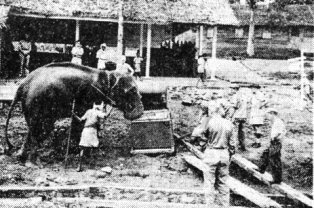
|
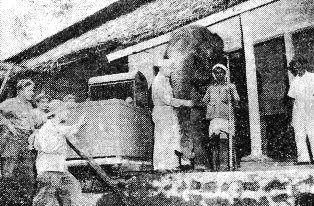
|
SHOE ON OTHER FOOT IN FATHER-SON TEAM
1328TH ATC BASE UNIT, ASSAM - It's usually the father who offers guidance and advice to the son, but the combination of the Army and India has proved too much even for such a stalwart tradition.
Cpl. Kadzie Goodwin arrived here recently on a change of station and not long afterward encountered his father, S/Sgt. William A. Goodwin, who he hadn't seen for more than a year.
Now Kadzie, a ground radio technician in the Army Airways Communication System, guides his father, an aerial radio operator flying The Hump for the ATC's India-China Division, over the treacherous transport routes between Assam and China.
This upset of tradition elicited this comment from the elder Goodwin:
"It seems kinda funny receiving instructions from my son, be he's a good boy and if it weren't for the swell job AACS is doing in providing us with hommings, weather reports and navigational aids, we'd really have tougher going than we do now."
At present father and son are occupying the same basha where Pa sometimes is tempted to pull both his age and rank on Kadzie to help put the place on the beam for inspections.
Mother and wife of the Goodwins junior and senior is Mrs. Louise A. Goodwin, Lake Road, Ithaca, N.Y. Kadzie is named after a World War I buddy of his father who saw overseas action in that one, too, and is well decorated as a result. Both volunteered in 1942, father preceding son by only a few months.
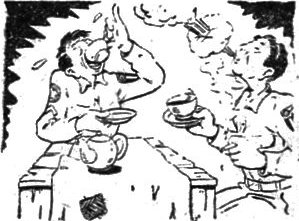
|
BURMA - Light plane pilots of an advanced Air Commando group let it be known that they have just discovered something our British cousins out here have known for some time - in this climate, tea is a top-hole drink, old chap.
The particular outfit, commanded by Col. Clinton B Gaty, is currently evacuating wounded from the Kabaw Valley. At the advanced strip, where the Indian and East African casualties are being picked up, the British medics have established a jungle tea room, used jointly by the Yanks and the British, while waiting for the wounded to be loaded on the planes.
Seated on cushions made from discarded food-drop parachutes, eating off boxes covered with parachute silk, the pilots regard the tea-room provided by the British as plumb luxurious.
Said one pilot: "It's like working out of the automat, only the seats are softer."
Bird Gets An Assist
10TH AIR FORCE FIGHTER BASE, BURMA - It passes from the ordinary to the noteworthy when a buzzard helps a pilot in combat.
This happened when Lt. Marion Ball, flying as part of an escort to a squadron on B-24's from the Seventh Bomb Group, dived on a Jap airfield looking for something to shoot up.
He found a Jap Oscar in a revetment - went in nose-down at about 400 mph, and got in a few good licks. The Oscar started to burn, worse than Edgar Kennedy.
"Just as we pulled away," relates Ball, "I turned around to watch. That was a mistake. I sailed right into the buzzard."
"But I was lucky. We were about 30 feet above the ground, and the sudden impact skewed my nose around. (The pane's nose, presumably - Ye Ed.) Off to the right was a machine gun pit. The swing-around left me heading straight for it. We got it. A buzzard was actually helpful, for once."
ACE SCRIBE LAYTHA CAUGHT OFF BASE
Letters From Airborne Engineers
To whom it may concern, particularly members of an Airborne (repeat) Airborne Engineer Battalion in North Burma:
In our Dec. 14 issue, we published a story by our able field correspondent, S/Sgt. Edgar Laytha, concerning construction of an advance strip in the Bhamo area.
It was an exciting article, and, relying on Laytha's reputation for veracity and accuracy, we printed his differentiation between the functions and equipment of the Airborne Engineers and the Aviation Engineers.
Judging from mail we have received from members of the Airborne Engineer battalion, from privates to majors and back, our man Laytha was somewhat off base. In fact, he was caught halfway between first and second, with his pants down, according to the Airborne boys.
First, casting no disparagement on the work of the Aviation Engineers, it is maintained that the strip into which Laytha flew was rendered serviceable by Airborne Engineers.
Second, it is further maintained that the Airborne guys built "90 percent of the fields being planted all around the enemy."
And, finally, it is maintained that while the Myitkyina airfield was completed by Aviation Engineers, it was the Airborne, flying in heavy Aviation Engineer equipment, who got the field in such shape that Aviation boys could come in later and finish the job.
To men of an Airborne Engineer battalion, our apologies. To correspondent Laytha, a dark look. - The Editor.
|
NEGRO CORRESPONDENT IN BURMA
Deton G. Brooks, Jr., Writes For Defender
BURMA - Deton G. Brooks, Jr., Jack to his friends, represents the Chicago Defender, the influential Negro newspaper, in this neck of the war. He is one of 15 negro war correspondents roaming the world battle fronts, and the only one in the Far East. The Defender, whose staff includes eight of these overseas reporters has a circulation of 300,000, and, in addition, Jack's feature articles are syndicated to other Negro

|
Jack likes to write about the colored truck convoyers and Quartermasters. But all this is only part of his duty. The readers of the Defender, Brooks is very emphatic about this, are interested in the Far East as a whole; they want to know the general trend of events and its political and economic implications upon the future. Jack reports this trend. You see him in Burma everywhere. One day he flies over the Jap lines on a leaflet-dropping mission and writes about psychological warfare. Another day he visits the forward echelon of the British 36th Division or studies the combat qualities of the Chinese.
Jack Brooks was a professor of mathematics at the DuSable High School in Chicago before he became a war correspondent. Simultaneously, he was the political analyst of the Defender, assistant to the editor and a special researcher on the legal aspects of neutrality at the University of Chicago, his alma mater. Jack holds the M.A.C. in International Relations and the B.S. in mathematics. He made his living, while a student at the University of Chicago, by being alternatively the manager of a movie theater and "Special Messenger to the President of Chicago's Union Tank Car Co. In between, he spent a couple of months at West Point, but had to leave because of athlete's heart. He is 35, married, prematurely gray, jovial and a good poker player.
Before he came to this neck of the war last September, Jack traveled through the Caribbean writing a series of articles on social conditions in Puerto Rico, which, while a very small place, Jack thinks has problems as complex as those of a larger country. Rexford Tugwell, Governor of Puerto Rico, impressed him greatly by his sincerity and loyalty to the President, even after he had been dropped from Cabinet office.
Brooks met many other celebrities in his professional career. He interviewed Mrs. Roosevelt at a large Negro rally in Chicago. The "candid way" in which the First Lady answered questions made him wonder often. She handles all questions so darned rapidly, Jack says, that it keeps a correspondent constantly on his toes and very often out of breath.
|
Madame Chiang Kai-shek was interviewed by Jack Brooks at a press conference at the Drake Hotel in Chicago. Brooks asked her whether she had any message to the Negro people of the United States. "I have the same message to the Negro people," replied Madame diplomatically, "as to all other people of the United States." Since America was a democracy, Madame saw no reason why any particular group "had to be singled out for special felicitations."
Jack personally knows, of course, Paul Robeson, Canada Lee and also Lena Horne. He met Lena in Hollywood just a few days before he sailed for India. He asked her whether she would be willing to entertain in the far East. If she were asked, assured Lena, she hoped it would be possible. Many of the colored boys along the Ledo Road have asked Jack about Lena Horne, and he still hopes to greet her in this part of the world.
Now, this is what Jack himself thinks about The Road, the colored G.I.'s in the India-Burma Theater, pot-war possibilities of Negro soldiers, the duration of the war and of life in general.
The Road: The Ledo Road is not only a Negro epic. It is an American epic in which the non-Negro Americans played just as an important part as the colored boys. They worked side by side and learned to respect their individual achievements.
The Colored G.I.: The Negro soldier, like any other American boy is trying to get the darned thing over as soon as possible and get home. This is the reason why he is doing his part so efficiently. Negroes are very proud of the contributions they have made, and they are very anxious that they receive full credit at home.
Post-war: The colored farm boys of the South have learned the use of heavy machine equipment and certainly they would want to transfer their abilities into better jobs. Naturally, they are very much concerned about their post-war possibilities, but hope to take advantage of jobs being rented for all G.I.'s.
Lastly, The Duration: Jack is out of touch with European events, but predicts a two year war with Japan after the defeat of Germany. he has no philosophy of war, none of life. Jack is just interested in life and in this interest he finds its meaning.
|
New and distinguished member to the "Earthquakers" Medium Bombardment Group 10th Air Force, is the 1,000th and last B-25 off the assembly line at the North American Plant, Inglewood, Calif.
The plane carries signatures of all employees at North American who had anything to do with her assembling. A short time later, while the hard-hitting Mitchell was at Kansas City for modification, a War Bond Rally was held and all Bond purchasers were permitted to add their names on the fuselage. Death Valley Scotty, reputed to be one of the richest men in the United States was one of those who inked his John Hancock. There isn't a spot left on the plane now that doesn't bear someone's signature.
By Gen. Hap Arnold's orders, the plane received publicity befitting her significance. At every base she visited, photographers swarmed upon her. Both the men and women who built her and War Bond purchasers will be apprised of her accomplishments in this neck of the war, because a periodical report will be written about what she does to the Japs. - By T/Sgt. WALLACE WEINSTEIN.
G.I. LAB UNIT SPIED UPON NIP EMPIRE
By Sgt. GRANT ROBBINS
CHINA - During the past 15 months, a handful of American G.I.s who worked in a small frame structure at the edge of a 14th Air Force field in East China have accomplished a task that will do much toward ending the far Eastern war on all fronts. They are a photo lab group with the "China Falcon" Photo Squadron. Working long hours in tropical heat at what they consider a routine job, they have written a solid chapter in the history of war photography - the unmasking of the face of the Japanese Empire.
The film over which they so painstakingly worked revealed defensive installations and centers of offensive preparation in the Philippines, Japan itself and the innermost parts of its Asiatic fortress.
ONE PHASE COMPLETE
When the fast, long-range photo ships, such as the one flown by Capt. Winifree Sorderett over Japan, returned to the advance base from a mission, only one phase of the reconnaissance was complete. Technician crews now took film from the planes cameras and hurried it to the lab shack. Developing and printing the film had to be done quickly and with more care than any film ever received, but with the use of portable and often improvised equipment.
Personnel of this lab unit, which was three times cited by Brig. C. D. (Casey) Vincent, of the 14th's East China Wing, consisted of 13 enlisted men and one officer, Lt. L. M. Braun, later replaced by Lt. W. T. Fleming. A number of the men were photo technicians in civilian life: T/Sgt. Hank Quirin, the lab's chief non-com, had been in the testing department of Eastman Kodak for 16 years, and the shift chiefs, S/Sgt. O. J. Testerman and Sgt. Bob Schworm, were pre-war cameramen. Other enlisted personnel included S/Sgt. Marvin Hayes; Sgts. Prichett, Carey, Ventresca, Cherner; Cpls. Connor, Feldman, Coveny, Wilson; and Pvt. Ted Hale. All of them are still in the China Theater and are closing in on their second year overseas.
CLOAKED IN SECRECY
What the men accomplished at that time was cloaked in secrecy as were the flights their pilots made. Their work is done now and their story largely told in the excellent results of the B-29 raids and Gen. Doug MacArthur's invasion of the Philippines.
For a year in advance, these "Flying Tiger" ships covered the inner bastions of the enemy's territory. The enemy was for the most part not aware of the large-scale reconnaissance until far too late. There were no bases so advantageous to Japan's enemies as these East China fields, when considered from the viewpoint of aerial photography. Maj. Gen. C. L. Chennault's men knew how to use that advantage. American, Australian, British and Chinese forces warring in all sections of the Orient benefited from this observation post.
For men at the photo lab life was considered pretty dull. They had hindrances not only to their world but to their limited rest and recreation. The lab was small and had to be in constant operation, making it necessary to work in shifts. It was hot as blazes during the summer. They could look out over the field and the surrounding hills and see heat waves rise from the parched earth's surface. At night it was somewhat cooler but there were Jap bombers attacking with tiring regularity. In a middle of a job with the film half processed an alarm would often be heard that would send them out to the caves and slit trenches. One night they had to was the film in a stream. But it turned out all right.
Water was always a great problem, as was electricity. Coolies hauled water in pails and for power there was a motor so small they laughed at it on first sight. The motor had the last laugh since it was the only one that would function with homemade parts and in the long run proved to be the most dependable of any sent forward.
During one month the photo pilots flew 49 missions, and that meant unending work for the lab men. Photo prints were usually needed immediately by Army intelligence or by 14th Air Force bomb squadrons. The men were required to work at a furious pace once they got their hands on the exposed film. Often a bomb squadron commander would stand at the door of the lab, his planes on the field warming their motors in preparation to take-off, urging the boys to "hurry up with those air dome shots." Prints would be made from wet negatives and turned over to the flight leaders; he would search than face of the dripping print with a trained eye, get the information and dash off to his waiting planes.
The lab worked 20 hours a day, seven days a week. The Japs favored it as a special target for raids, though luck always stood with the little shack - as luck will stand by the United nations forces in the Far East thanks to photo men in isolated outposts everywhere who do their "routine" jobs well in spite of any and all kinds of conditions.
BURMESE LADS WALK 900 MILES
|
THE WOMBAT SQUADRON - The story of how two Burmese youths walked 900 miles over some of the most treacherous terrain in the world to evade the Japanese and join the American forces was revealed recently with the appearance of two new waiters in the officers mess hall at this "Liberators of China" field.
Its opening scene is staged in Mandalay, where the Chan family had been residing since their departure from Rangoon many years before. The American Volunteer Group was bringing America into the thoughts and imaginations of the Burmese with its daring adventures. It was a day and time when AVG meant America "very good," and Jap fifth columnists were filtering into Burma's cities. On April 3, 1942, the Japs struck. In a matter of hours, Mandalay was reduced to ashes.
Following in the footsteps of their mother and older brother, who had left long before, Charlie and Johnny Chan started walking. They walked north, for north was the only direction away from the enemy. They did not stop walking until they reached Myitkyina, 210 miles away. With the Japanese overrunning Lashio, the two boys could only pause momentarily before joining a few other refugees and a native guide, who led them eastward toward Yunnanyi. On June 15, after 67 days of walking over 500 miles of mountainous country, Charlie Chan and his brother, Johnny, reached Kunming and there affected a joyous reunion with their mother.
The two brothers proceeded on to Liuchow, this time with the helping hand of spasmodic transportation, and there they stayed for two years, working with the American forces. When Liuchow was evacuated in early December 1944, they made their way, on foot again for the most part, to this base.
It is impossible to appreciate fully the rigors of the 900-mile trip without a look, first, at the two persons involved and, second, at a map of the area traversed. Though 20 years of age, Charlie Chan is hardly more than five feet two inches tall, and very slight of stature. Johnny is 18 and even smaller. To be that young and that physically small and yet to walk 900 miles over level countryside is in itself a story worth relating. The Myitkyina-Yunnanyi route is a far cry from the plains of Kansas or even the rolling hills of Pennsylvania. It is a route criss-crossed by the surging, often swollen Irrawaddy and Mekong Rivers, and by the mighty Salween River, on whose west bank blows a west wind that shifts south on its eastern side in one of those puzzling phenomena of weather. It is a route over pathless peaks that sometimes tower 10,000 feet into the air, where winds of tremendous velocity buffet any object, animate or inanimate. In short, it is a route which is a challenge even to the airplane and to the skills of a pilot and navigator.
And so it is reasonable to believe that, if the hearts of Charlie and Johnny Chan are any criterion, the fate of the Japanese, however long delayed, will eventually be realized.
Mars Topkick Saves Bacon As Nips Shell
By M/Sgt. RAY F. MITCHELL
MARS TASK FORCE, BURMA - First Sergeant Charles F. Clancy, topkick of an infantry company, is in favor of sheltering the bacon when someone else brings it home.
Clancy's outfit had moved into the little village of Tonkwa and had made contact with the Japs. The Japs had been in the habit of throwing in a few artillery shells for several days. The battalion had been living of "C" and "K" rations for quite some time and was getting "fed up" on them to a man.
Then - oh, happy day, some 10-in-1 rations came in.
CLANCY ALL SMILES
Clancy was all smiles as he cooked his "10-in-1" ration bacon. Then tragedy struck, "Whistling Eillie," the Jap artillery, started throwing them in thick and fast.
Clancy was quick to react. In one hand he grasped the can of bacon, in the other hand he had the mess kit and frying pan full of half-fried bacon.
Corpulent Clancy made a dash for the nearest fox-hole. Two men already had beat the sergeant to the hole, but there was still a little room left.
FRAME LEFT TO SUFFER
Instead of tossing the bacon away and hitting for safety, Clancy instead calmly lay down near the fox-hole, holding the bacon down in the hole, leaving his 215-pound frame outside to suffer.
The shelling stopped and Clancy went back to frying his bacon. Someone asked him to explain his actions during the shelling and he answered them very simply, "I couldn't bear the thought of losing that bacon."
For the heroism shown by Clancy under fire, and his meritorious achievement in protecting his bacon without regard for his own personal safety, his comrades have awarded him the "Chow Hound Cluster."
|
Air Team Quartet
TENTH AIR FORCE HQ., BURMA - Award of the Silver Star to four men of a Tactical Air Communications Squadron of the 10th Air Force, EAC, for gallantry in action as a team under enemy fire, has been announced by Maj. Gen. Howard C. Davidson, Commanding General, 10th Air Force.
Air Force personnel without wings, the team - consisting of Capt. Floy L. Parsons, Sgt. Rufus Fields, Jr., Cpl. Heimie H. Coren, and Pfc. Douglas J. Bragg, saved communications equipment vital to air operations from capture by the Japs in Burma recently.
HEROIC TEAMWORK
While the Silver Star is normally given only to one outstanding individual for exceptional heroism among soldiers fighting with exemplary courage, the air team soldiers combined their efforts so successfully in fulfilling their missions that an award was made to each member.
Advancing with front-line Allied ground forces units in North Burma, the air team was directing fighter-bombers to targets a few hundred yards forward when the order was received to set up a position near a bridge. Reaching their objective, Parsons and his men set up their radio set, though subjected to fire from enemy snipers and machine guns.
DIDN'T EVACUATE
One hundred yards ahead, the Infantry met stiffened resistance and was forced to withdraw on both flanks of the radio installation. The Japs counter-attacked; the air team was ordered to retreat quickly to escape the Japs. Rather than destroy the valuable radio or permit the set to fall into the hands of the enemy, the four men displayed extreme courage by dismantling the set and carrying it to safety under intense Jap fire.
The citation with the Silver Star states in part: "By their valorous action, communications equipment vital to air operations in Burma was saved. Their gallantry in action reflects the greatest credit on the Army Air Forces of the United States."
Parsons, then a first lieutenant, was promoted in the field for his devotion to duty during this engagement with the Japs.
Forward Base Of Oil Pipeline Moves Ahead
by HUGH A. CRUMPLER United Press Correspondent
PIPELINE CONSTRUCTION CAMP, NORTHEAST BURMA - This forward construction base of the world's longest pipeline grows closer to China every day in a line the crow flies.
Unfortunately, however, you can't lay pipe across rivers, through jungle and over mountains in a straight line. In this difficult terrain, the 'round about route - the line of least resistance - is the quickest.
So, although men of this Engineer Petroleum Distribution Company can almost see the goal, there's still a lot of work to be done before the long gasoline carrier snakes its way across the border and heads for an undisclosed point in China from Calcutta.
They've come a long way since their first assignment in the India-Burma Theater, installing the gasoline distribution system at 20th Bomber Command for the first Super-Fort raid on Japan. The company has leap-frogged up India and across Burma, construction a section of the line, then hopping ahead of two or three other companies, which in turn pass them.
FROM TEXAS, NEW YORK
The men of cap. Louis W. Gwin's company come from about every State in the Union, but most of them are Texans and New Yorkers. The majority of them are former oil field and pipeline workers and a few worked on the Big Inch, which they consider was just a warm-up when compared with wrestling a pipeline through India and Burma.
After completing the B-29 installations, and beating the deadline by two weeks, the company joined four other companies in constructing the pipeline across the plains of India and into the Himalaya foothills.
The thermometer skyrocketed to 120 degrees in the shade and a man could blister his hands by repeated handling of the hot pipes without gloves. The men found out in a week - after several had been laid up with heat stroke and severe sunburn - that the Army wasn't joking when it stated it is unsafe to work in the open sun between 10 a.m. and 3 p.m. without shirt and hat.
Their record in India, was 80 miles of pipe jointed, buried, cleaned and tested in three weeks.
ARRIVED WITH MONSOON
The company arrived in Burma with the monsoon. Cutting their own right-of-way through the jungle, carrying-in pipe on their shoulders and sometimes wading waist-deep in water, they still averaged three to four miles a day. At the end of the monsoon, across a valley in which trucks bogged down in mud, they put down 22 miles in a week. Every mile in the pipeline means 264 connections.
Like all American units in Burma, the company has its hunter who relieves the monotony of canned ration with occasional fresh meat from the jungle. Cpl. John Walker has brought down a number of deer with his carbine and thereby earned the undying gratitude of the harassed mess sergeant.
Hero of the company's favorite animal story is the first cook, Sgt. Nesbitt G. (Buck) Williams, who went to get water from a stream and almost scooped up a bathing elephant. According to the men, the hot cakes were flat that morn.
Doomed Fighter Destroys Zero In Death Throes
14TH AIR FORCE BASE, CHINA - One last kick out of a stricken fighter plane before it snapped over and headed to a crashing doom on the ground recently cost the Japanese Imperial Air Force a pilot and one Zero.
White and black smoke streaming from his plane after it was hit during an aerial gun battle with the Japanese, Lt. Jack E. Gocke, 22-year-old Chicagoan, flying with The Black Lightning Squadron of Maj. Gen. C. L. Chennault's 14th Air Force, radioed his wingman that his plane had been hit and then he pulled into an overcast to shroud his parachute escape.
Preparations all made, Gocke was about to leave the cockpit when the plane came out of the overcast and a Jap Zero was diving at it head-on.
"I settled back in the cockpit, lifted the nose of the plane and gave the Jap a long burst and he went by me smoking and burning," explained the young pilot after he was back safely at his base.
After the burst, Gocke's plane was finished and the propeller had almost stopped turning. The plane stalled and snapped over. His parachute opened in time for him to see the Jap plane go straight into the ground and explode.
The Nip pilot did not bail out.
HOW C & I-B G.I.'S SPENT CHRISTMAS
|
|
Roundup Staff Writer
Christmas Day, 1944, presented many different kinds and varied measures of Yuletide celebration to G.I.s in the China and India-Burma Theaters. To some it means a holiday, gifts from home, parties, dances and, no doubt, a few hangovers. To others it was ducking in slit trenches, extra patrol duty, bombs and rifle fire from the Jap. And yet most enjoyed something in common: The traditional Christmas dinner (if only it was just a little something 'extra') and a few hours reminiscing of happier Christmases and dreaming of still happier ones to come.
In China, 14th Air Force pilots, filled with the spirit of giving, presented the Japs with a few special "gifts," destroying over 40 Nip planes in Christmas Eve attacks. The Japs, however, returned the favors with a four-hour strafing on SOS Headquarters and nearby areas, chasing G.I. revelers into slit trenches.
The Japs didn't spoil all the fun, however. The year's first beer to reach China, strictly rationed, was received by thirsty troops. Packages from home brightened the day. A few of the boys, including S/Sgts. Lyman C. Blum, Curtis L. Jarrett, Virgil Peoples and Leo S. Duffy, produced a number of gaily-lit Christmas trees.
There were also the usual church services. Lt. Col. Joseph P. McNamara, Assistant Theater Chaplain, and his staff of Chaplains and local missionaries took a special Christmas message to frontline troops and outlying China posts. Soldiers used their PX rations as gifts for blind and orphan Chinese children. A group of Master Masons banded together to aid a local mission school for blind Chinese girls.
But with it all, the main business of waging war on the Jap continued. Fighters and bombers carried out regular missions. Supplies kept rolling to the front. The war went on.
To the troops in the forward areas of North Burma, Christmas was far from being a holiday. Regular duties were performed. Patrols were even more alert. Celebrating, such as it was, took place only during the few scattered free hours, with Christmas trees and decorations missing, except in individual cases.
The men did get a few Christmas extras though. During the preceding week, 13 cargo planes were used especially to bring in packages from home. Special rations for a turkey dinner with all the trimmings were also flown in. Roast goose was delivered to troops on combat missions.
Similar "celebrations" prevailed along the Ledo Road. Pvt. Roy Russell's "holiday" is typical. Christmas Day found Russell, with his buddies, pushing a truck convoy across the Patkais, carrying supplies to the front. Then, at noon, a 30-minute break for cold C-rations. Except for a warm turkey dinner waiting for him at camp, Christmas was just another Monday.
At Base Headquarters in Assam, there was semblance of a real Christmas. Services were held. Truckloads of G.I.'s sang carols. Tables were loaded with canned turkey, dressing, peas, asparagus, potatoes, pies. Packages had arrived from home. Hospitalized G.I.'s decorated their wards for Red Cross parties. But, at day's end, the Road and the pipeline were a little longer.
Holiday celebrations at a 20th Bomber Command base in India were interrupted when a Jap bomber passed over and dropped a few "presents." No damage was done and impromptu parties were soon underway. There was Christmas dinner and special church services.
|
A mild tragedy was averted when Christmas trees were delivered to the Red Cross Club. Indian bearers, not hep to the situation, cut them in half and planted them in the yard. The mistake was soon discovered, the trees dug out, nailed together, and there was "Christmas as usual."
In the rear areas, secluded from enemy attack, holiday spirit ran high among Americans. Eastern Air Command Headquarters personnel held midnight mass in Calcutta. American and British soldiers and WACs formed choirs and sang carols. Gala parties and dances were held in Red Cross Clubs with WACs as hostesses. G.I.'s and WACs played Santa Claus to an Indian orphanage, giving toys and candy and ice cream.
A concert by the combined Base Section 2 and Calcutta Symphony Orchestras under the direction of recently-arrived American conductor Andre Kostelanetz highlighted an SOS program.
Then, of course, there was New Delhi. Naturally, Connaught Circle Commandos had an enjoyable time. That is, all except one Pfc. Robert Buich. His face wreathed in smiles of expectancy, he tore open his box. One look at its contents, his face turned a peculiar green. "Sweating out 33 months in India isn't bad enough," he groaned, "I've gotta get SPAM for Christmas!" (Cheer up, Robert, others have suffered the same fate.)
|
CHINA - (ANS) - His eyes bleeding from imbedded fragments of a Japanese shell, Capt. Eugene Meyer flew his P-51 back to his base by the voice and barely visible wing tip in another P-51.
Wing to wing, Meyer and Lt. John E. Egan raced back to a 14th Air Force base after a strafing mission during which Meyers' plane was hit by ground fire.
While a flight surgeon stood by to give emergency treatment, Egan talked Meyer down to a runway via their radios. Meyer said the wingtip of Egan's Mustang was only a blur in his eyes.
As the wheels of Meyers' plane touched the ground, Egan pulled his plane up and went around the field again to land.
ARNOLD PRAISES I-B AACS UNIT
Gen. Henry H. Arnold has commended nine enlisted men and two officers of the Army Airways Communications System of the I-B Theater for accomplishing a special mission under "severe difficulties."
Capt. Norman J. Cohen and Lt. Henry S. Mika, who headed the mission, were the officers commended. The enlisted men were T/Sgts. Paul L. Brown and Howard L. English, T/3's Howard C. Edwards and James M. Graves, T/4's John F. Corrigan, Richard D. Loew and Bernard R. Miller, Cpl. Robert L. McElhency and T/5 Robert C. Pierce.
Their mission consisted of installing facilities characterized by Arnold in his commendation as "the first of their kind to be installed by American forces in combat zones." Their task, he wrote, "was accomplished in the face of severe difficulties caused by adverse weather conditions and attendant transportation problems." - By Sgt. WILL CHASAN
|
It's A Rough War For Us G.I.'s
By T/1 DYOLF RETLAW Roundup Staff Writer
It is such a dispiriting holiday season for the China and India-Burma Theaters. Solicitous groups of touring Congressmen have just returned to the U.S.A. from visits to the European and Pacific Theaters. And beauteous Rep. Clare Boothe Luce (R-Conn.), who accompanied the group of 15 to the Western Front, made a special side trip to pay her respects to the Fifth Army in Italy, this in spite of the exquisite torture of an earache. None, however, have knocked at our humble doors, and the Roundup has now sadly surrendered the last flickering hope that they might.
Mind you, this is not a complaint that the I-B and China Theaters have been ignored. Indeed, we can picture the globe-trotting legislators fretting because they couldn't drop into our neck of the war for a spot of tea. But, after all, their time is strictly rationed. From various authoritative sources, including our old friend, the Swedish Traveler, we learn that the halls of Congress are bulging with new bills of more varieties than claimed by Heinz. So just regard it as tough luck, men, decreed by harsh fate. Chin up. Let's have no display of wounded feelings.
Still, the Congressmen would not have been the losers had they visited us. We would have allowed them to exercise their tonsils to keep them in shape for the rigors of the Capital Hill season. This would not only have probably pleased them, but perhaps gratified the G.I.'s too, who have had to be content with the second-rate oratory of Army brass hats reading the Articles of War, every hour, on the hour, every six months.
There's no assurance, of course, that the touring Congressmen would see the beautiful Taj Mahal. But so far as we know there hasn't been a visitor of note who has failed to view the breath-taking edifice. The decrepit Leaning Tower of Pisa is an ugly pile of stone, sorely in need of an overhaul, compared with the delicate architecture of the Taj, and if La Luce was charmed by that blot on the landscape, how the Taj would enrapture her.
Oh, we'll grant there might be hardships to face. For instance, there is always the outside chance that the party might, through some grave error, be switched from airplane travel to an Indian railway. This would throw a monkey wrench into the delicate machinery of the House of Representatives. It might be weeks before they would be heard from again, and after suffering the tortures of the damned, including frustration, lack of amenities and the inevitable G.I.'s, they would need a considerable recuperative period.
Worse, they might become involved in the maddening intricacies
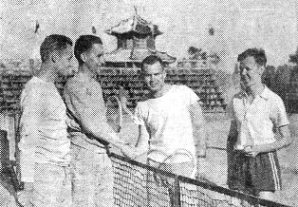 Congratulations are being extended to Sgt. Maurice Young, Santa Ana, Calif., and Capt. Francis Tucker, Chicago, on the right side of the net, from Lt. Frederick Witherby, Providence, R.I. and Capt. William Lockwood, Princeton, N.J., whom they defeated 8-6, 6-3, 3-6, 4-6, 6-2, in the finals of the All-American tennis tournament, sponsored by the 14th AF in China. A gallery of 750 Chinese and Americans watched the finals. Unseeded Tucker, from the Surgeon's office, won the singles title, beating Capt. jack Alley, 6-3, 6-1, 7-5. He lost only one set in reaching the finals, while Alley, third-seeded, dropped none before meeting the champion.
Congratulations are being extended to Sgt. Maurice Young, Santa Ana, Calif., and Capt. Francis Tucker, Chicago, on the right side of the net, from Lt. Frederick Witherby, Providence, R.I. and Capt. William Lockwood, Princeton, N.J., whom they defeated 8-6, 6-3, 3-6, 4-6, 6-2, in the finals of the All-American tennis tournament, sponsored by the 14th AF in China. A gallery of 750 Chinese and Americans watched the finals. Unseeded Tucker, from the Surgeon's office, won the singles title, beating Capt. jack Alley, 6-3, 6-1, 7-5. He lost only one set in reaching the finals, while Alley, third-seeded, dropped none before meeting the champion.
|
Or. oh. fate worse than death, they might be inveigled by unthinking characters into sampling of the spirituous likkers indigenous to our sector of the war. Such delicate abdominal linings, accustomed to rich, full-bodied bourbon (remember?), would doubtless be irreparably damaged by such dubious devil's brew as Lily Gin, Fighter Brand, Whiskey, Chungking Vodka or Kunming Orange Brandy.
Well, be that as it may, we wonder whether the junketing Congressmen have ever thought about their post-war futures? True, there will be the American Legion, the Veterans of Foreign Wars and similar organizations. But what of the 1950 pressure group - a vast, powerful, vocal block of ex-servicemen and women (to be known as the "Legion of Them That Never Got Called Upon"), a force dedicated to removing from office, by orderly processes, of course, ALL legislators who gave them the brush-off? There may be a day of reckoning.
This is not the first time, of course, we've been overlooked. Up to Wednesday noon, no Red Cross Club has informed has informed us of Eleanor's dropping in to serve tea to the G.I.'s. Now don't get us wrong. She may have been here, be we just haven't heard about it. On second thought, we'd have heard about it.
Think of the marvelous opportunity afforded the touring Congressmen. Imagine exploring virgin territory, unreached yet by Eleanor.
The C.B.I. Roundup is a weekly newspaper of the United States Forces, published by and for the men in China, Burma, and India, from news and pictures supplied by staff members, soldier correspondents, United Press, OWI, and Army News Service. The Roundup is published Thursday of each week and is printed by The Statesman in New Delhi and Calcutta, India. Editorial matter should be sent directly to Capt. Floyd Walter, Hq., U.S.F., I.B.T., New Delhi, India, and should arrive not later than Sunday in order to make that week's issue. Pictures must arrive by Saturday and must be negatives or enlargements. Stories should contain full name and organization of sender. Complaints about circulation should be sent directly to Lt. Boyd Sinclair, Hq., U.S.F., I.B.T., New Delhi, India. Units on the mailing list should make notification of any major change in personnel strength or any change of APO.

JANUARY 4, 1945
Adapted from the original issue of C.B.I. Roundup
Copyright © 2007 Carl Warren Weidenburner
TOP OF PAGE PRINT THIS PAGE ABOUT THIS PAGE SEND COMMENTS
PREVIOUS ISSUE CLOSE THIS WINDOW NEXT ISSUE
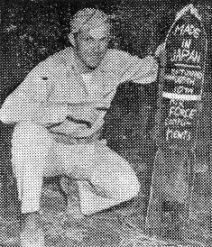
 The Asia-trotting USO troupe 269 contributes an exceedingly presentable homegrown cheesecake picture. Several
silver-tongued orators at the Ramgarh Training Center convinced Patricia Flynn she should show the camera how a girl
ought to look in a sari.
The Asia-trotting USO troupe 269 contributes an exceedingly presentable homegrown cheesecake picture. Several
silver-tongued orators at the Ramgarh Training Center convinced Patricia Flynn she should show the camera how a girl
ought to look in a sari.
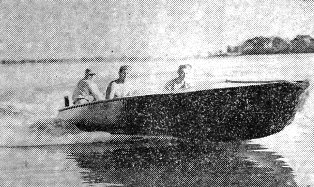 Capt. Donald Cutter, Sgt. Leonard Vandegriffe and Capt. Claire E. Sitts test the flagship of the Burma Peacocks
navy on the Irrawaddy River. The former Jap boat, made of teak, was rebuilt by the ASC men to be used in crash
rescue work.
Capt. Donald Cutter, Sgt. Leonard Vandegriffe and Capt. Claire E. Sitts test the flagship of the Burma Peacocks
navy on the Irrawaddy River. The former Jap boat, made of teak, was rebuilt by the ASC men to be used in crash
rescue work.
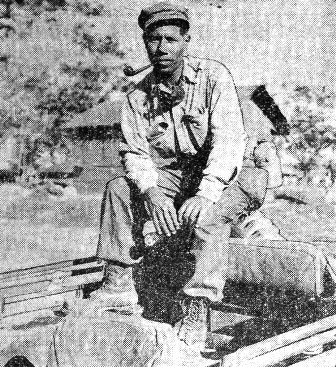
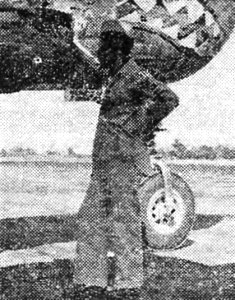
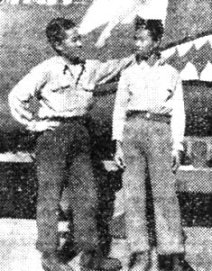
 Decorated with the Silver Star for gallantry in action were, left to right, Capt. Floy L. Parsons, Cpl.
Heimie H. Coren, Sgt. Rufus C. Fields, Jr., and Pfc. Douglas Bragg. Bragg cranks the hand generator of the field
radio set which the air team unit risked their lives to save in Burma during a brush with the Japs.
Decorated with the Silver Star for gallantry in action were, left to right, Capt. Floy L. Parsons, Cpl.
Heimie H. Coren, Sgt. Rufus C. Fields, Jr., and Pfc. Douglas Bragg. Bragg cranks the hand generator of the field
radio set which the air team unit risked their lives to save in Burma during a brush with the Japs.
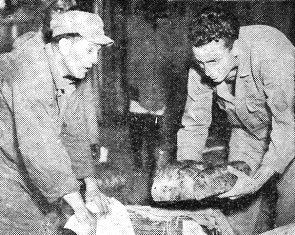 Christmas dinners were air-dropped to many American fighting troops in Burma. More than 700 geese and 300 pounds
of fresh raisin bread were supplied. The Red Cross donated Christmas kits. S/Sgt. Clarence
Dalke and Pfc. J. Rupert
Harless, Quartermaster truckers, are shown packaging dinners.
Christmas dinners were air-dropped to many American fighting troops in Burma. More than 700 geese and 300 pounds
of fresh raisin bread were supplied. The Red Cross donated Christmas kits. S/Sgt. Clarence
Dalke and Pfc. J. Rupert
Harless, Quartermaster truckers, are shown packaging dinners.
 Four 14th Air Force staff sergeants in China didn't let the fact that they were thousands of miles from home
dampen their Christmas spirit. Gathering salvaged material for an electrical display, they decorated a pine branch,
around which they piled up gifts from Shangri-La and from one another. Left to right, standing, Lyman C. Blum,
Curtis L. Jarrett; kneeling, Virgil H. Peoples, Leo S. Duffy.
Four 14th Air Force staff sergeants in China didn't let the fact that they were thousands of miles from home
dampen their Christmas spirit. Gathering salvaged material for an electrical display, they decorated a pine branch,
around which they piled up gifts from Shangri-La and from one another. Left to right, standing, Lyman C. Blum,
Curtis L. Jarrett; kneeling, Virgil H. Peoples, Leo S. Duffy.
 Arthur (Red) Patterson (right, holding baseball), writer for the New York Herald-Tribune, shown touring the Burma front with the USO troupe of major league players, talks with American Infantrymen of the Mars Task Force in their bivouac area. Also seen (left center, wearing dark cap) is Paul Waner, another member of the troupe.
Arthur (Red) Patterson (right, holding baseball), writer for the New York Herald-Tribune, shown touring the Burma front with the USO troupe of major league players, talks with American Infantrymen of the Mars Task Force in their bivouac area. Also seen (left center, wearing dark cap) is Paul Waner, another member of the troupe.
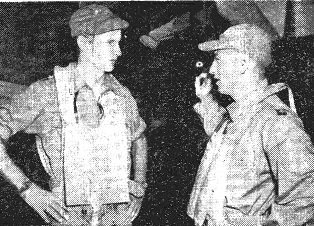 Maj. Robert Morgan, famous pilot of the B-17 Flying Fort Memphis Belle, and Brig. Gen. Emmett (Rosey)
O'Donnell, Jr., former CBI-lander and mission leader, prepare to get into their B-29, which led the first B-29
Super-Fort raid on Tokyo.
Maj. Robert Morgan, famous pilot of the B-17 Flying Fort Memphis Belle, and Brig. Gen. Emmett (Rosey)
O'Donnell, Jr., former CBI-lander and mission leader, prepare to get into their B-29, which led the first B-29
Super-Fort raid on Tokyo.
